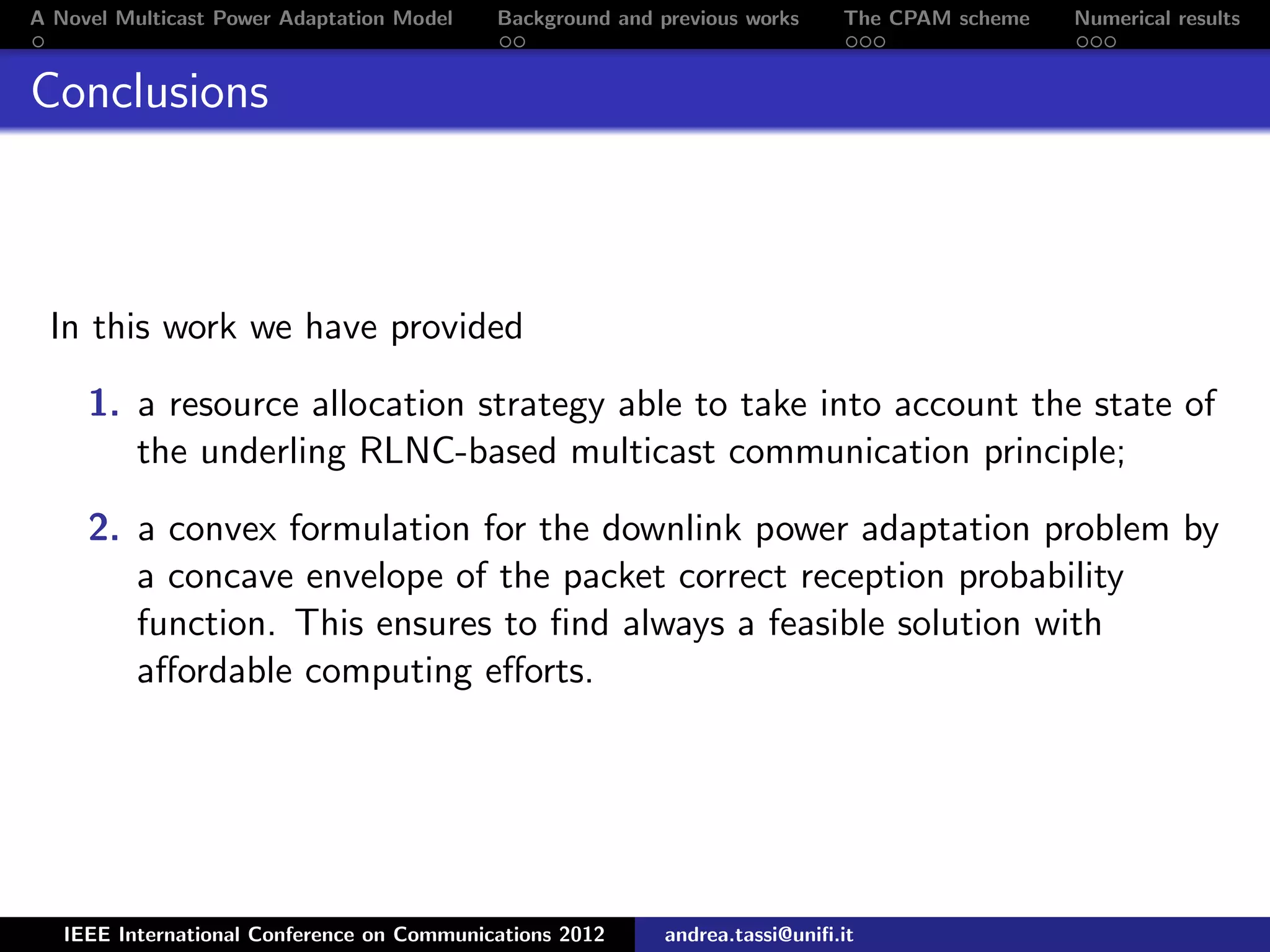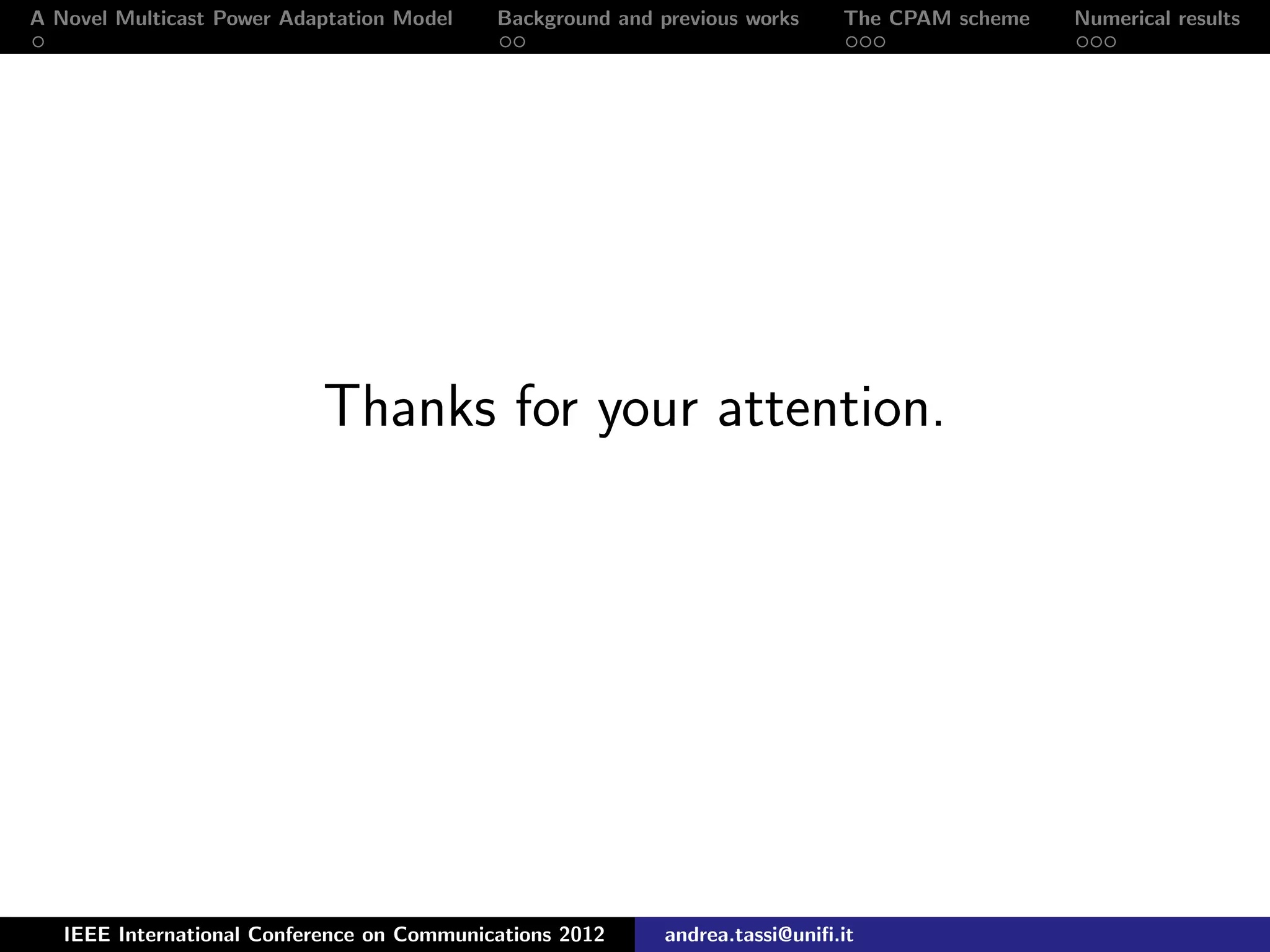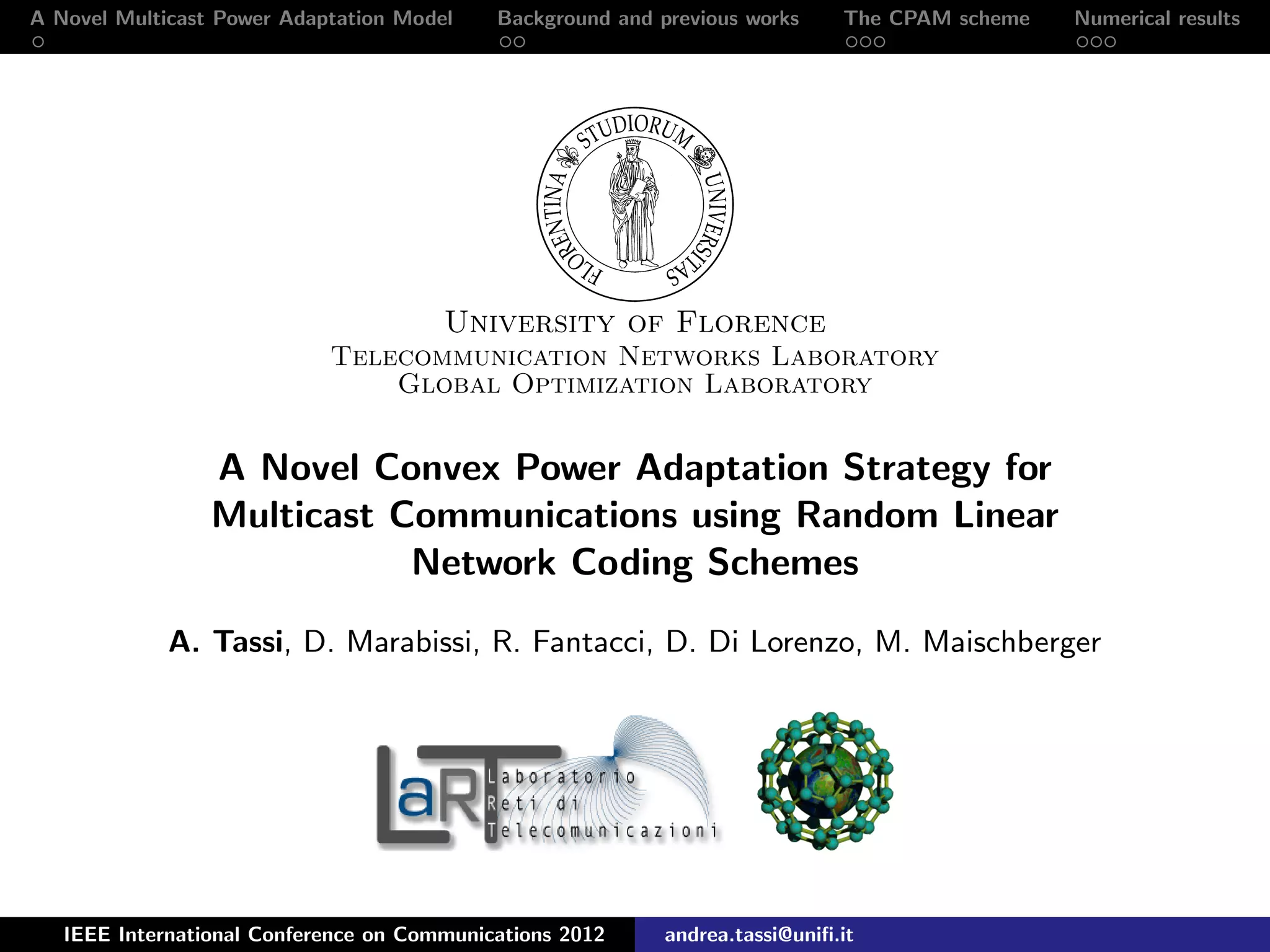This document presents a novel convex power adaptation model for multicast communications in LTE systems, focusing on resource allocation using random linear network coding. It introduces a strategy that accounts for varying propagation conditions across multicast groups while ensuring fair power adaptation and optimization of system throughput. Numerical results from simulations demonstrate the effectiveness of the proposed model compared to existing strategies.
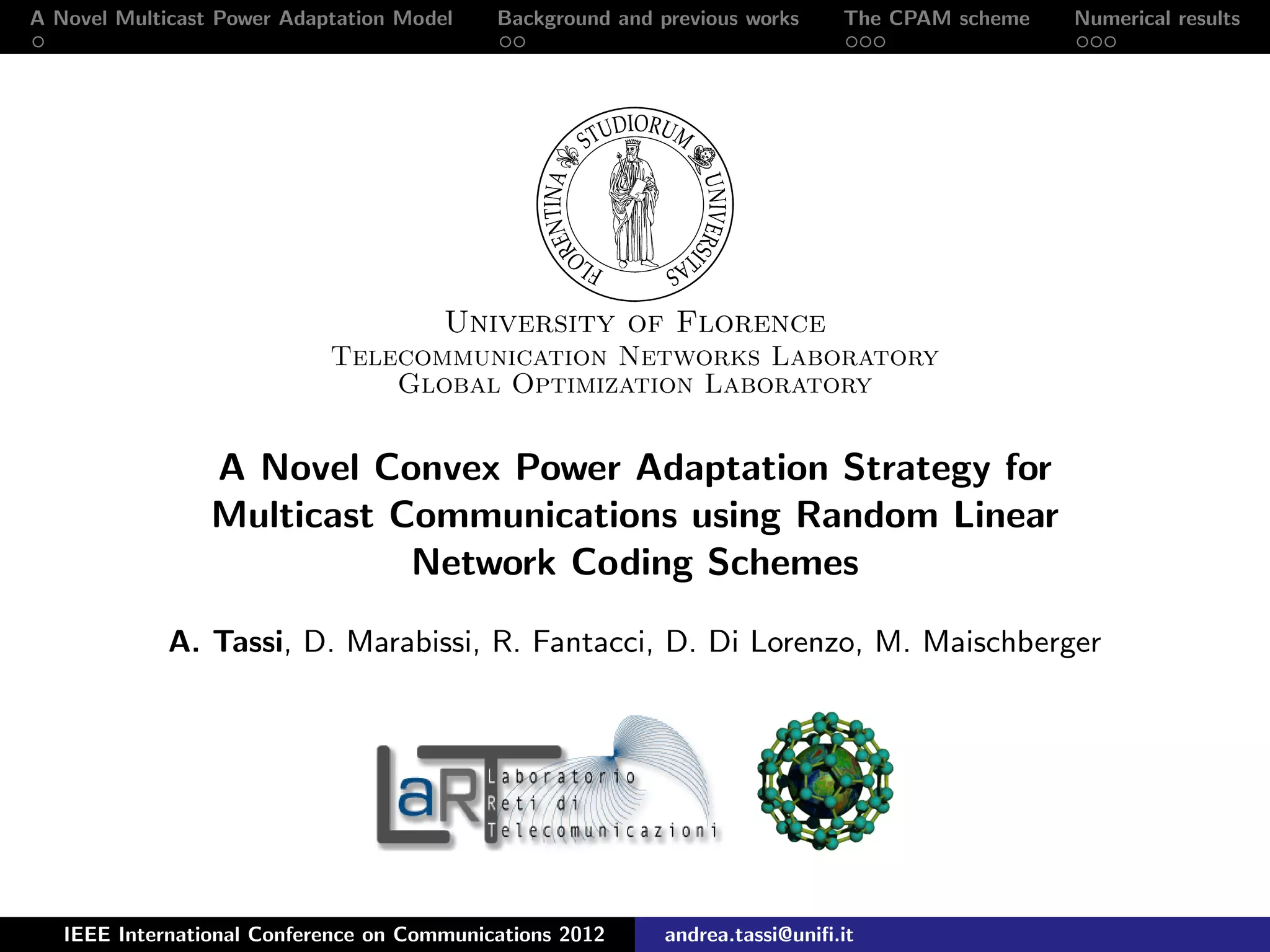
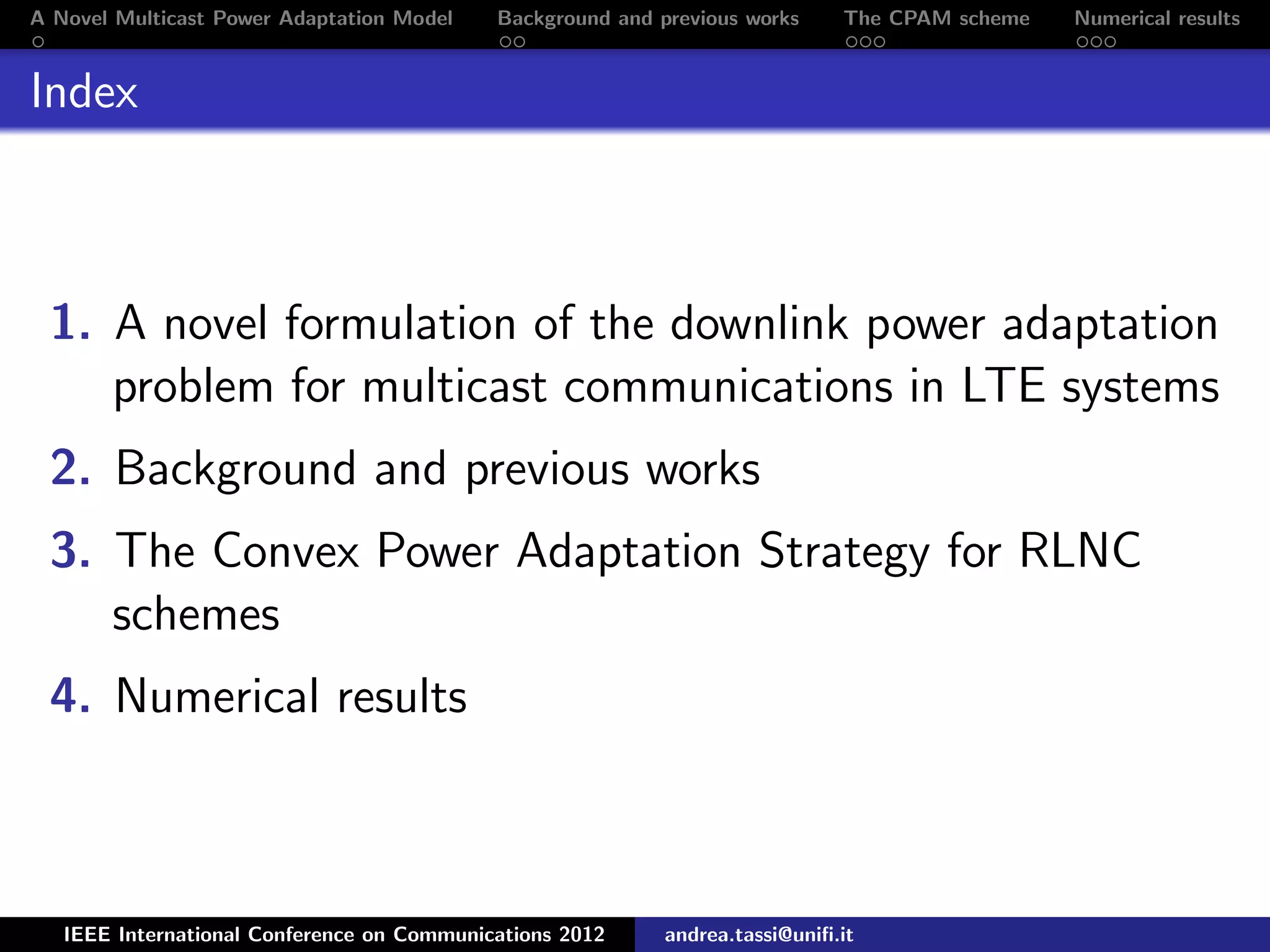
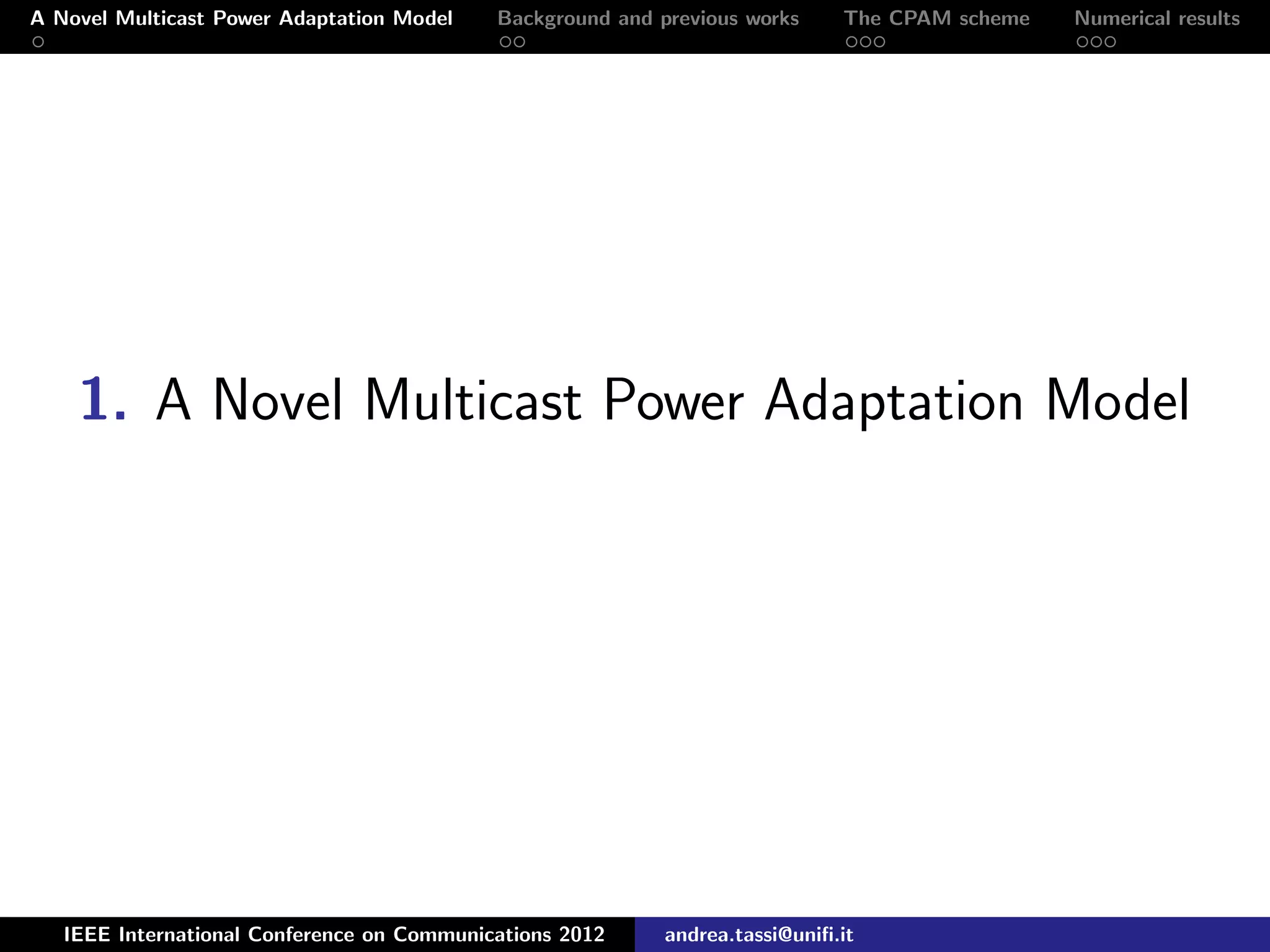
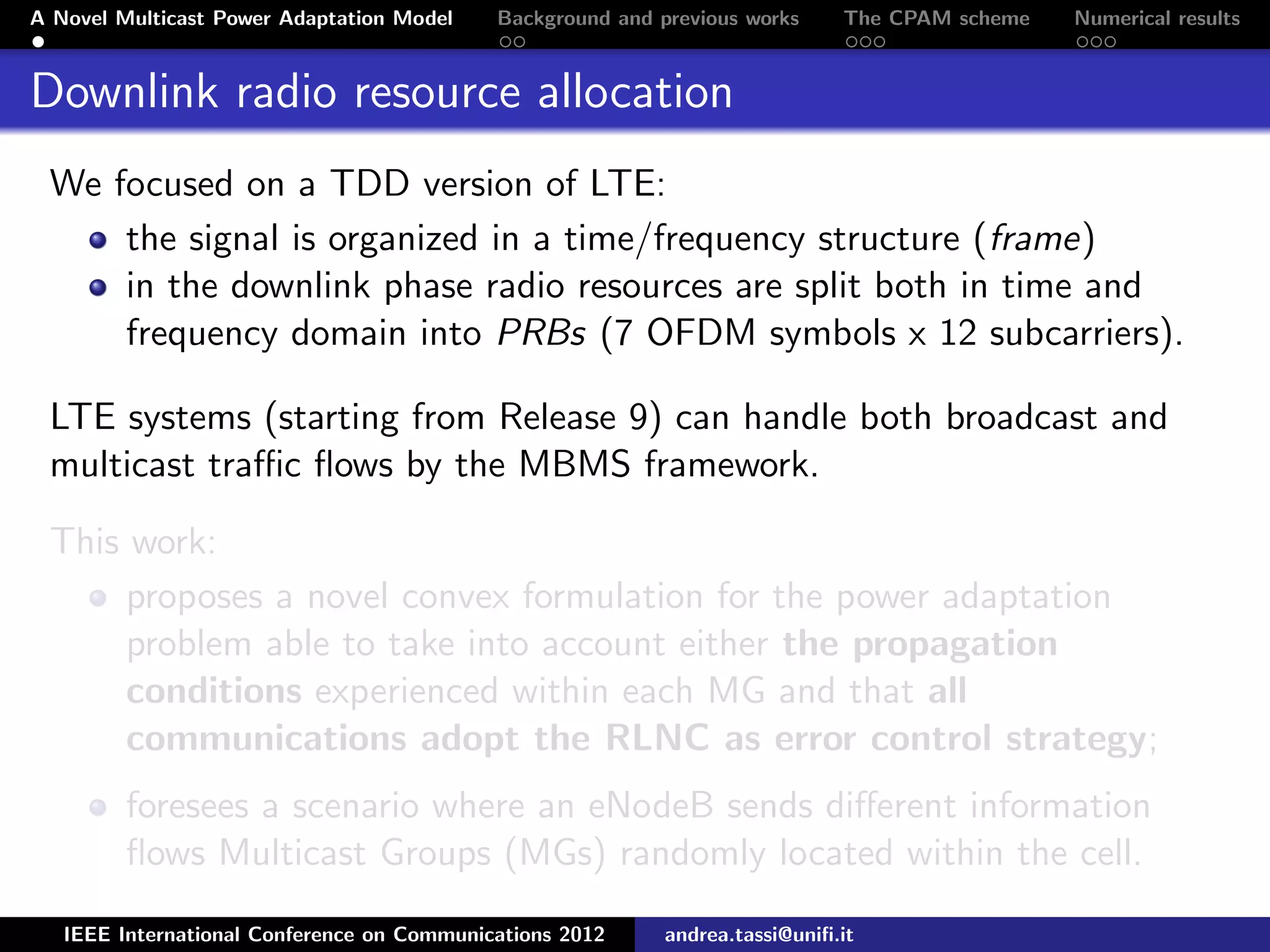
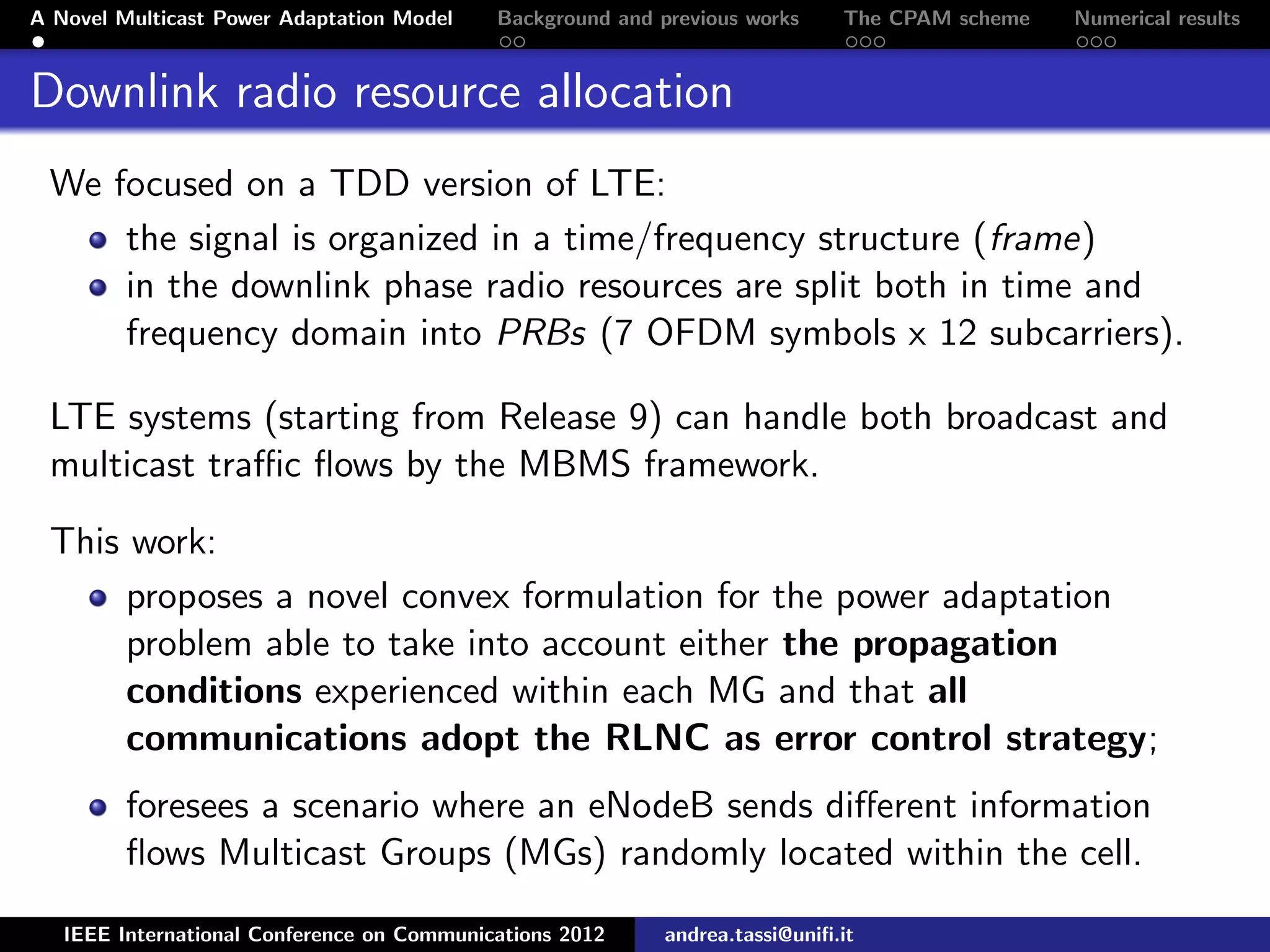
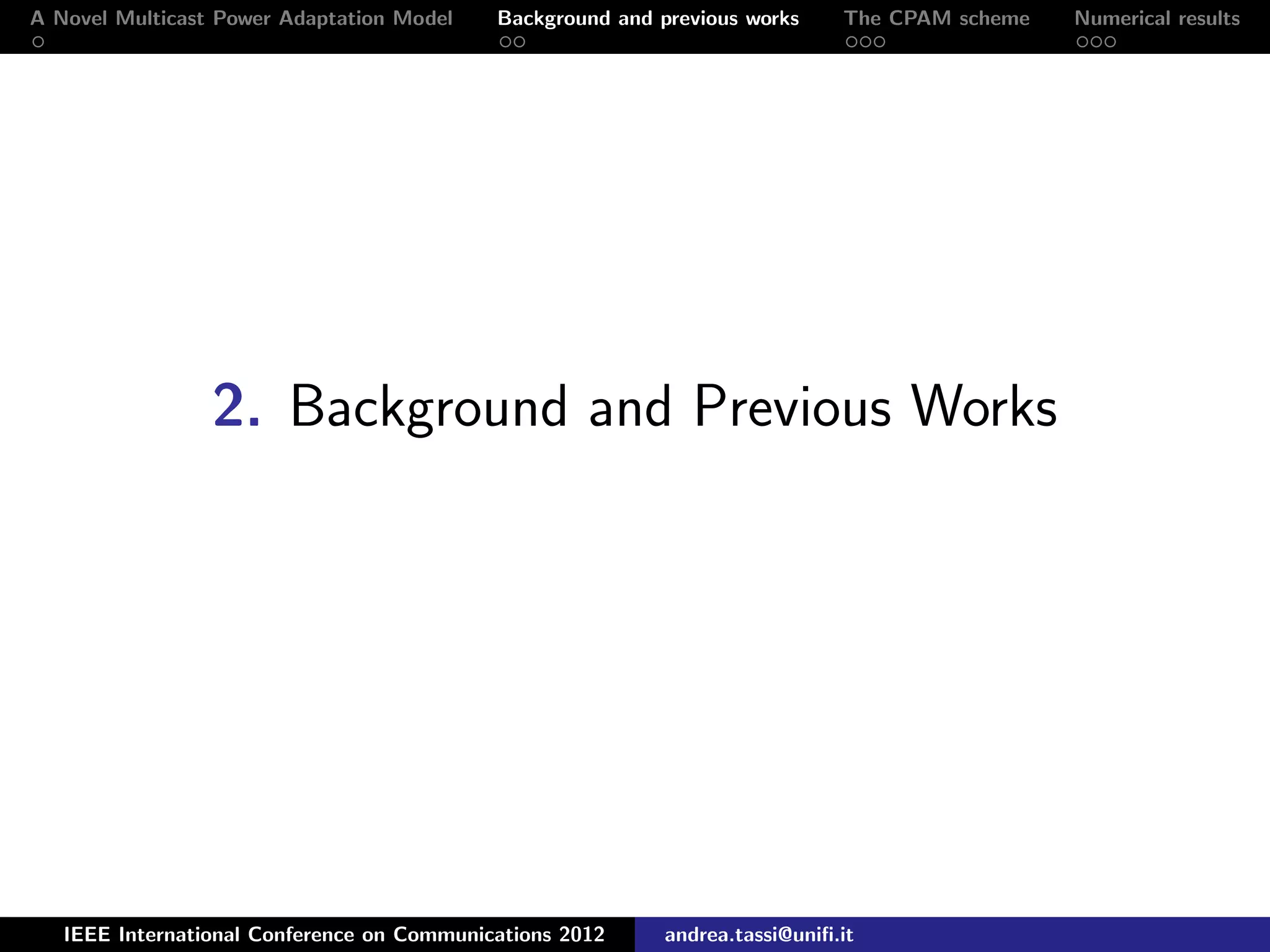
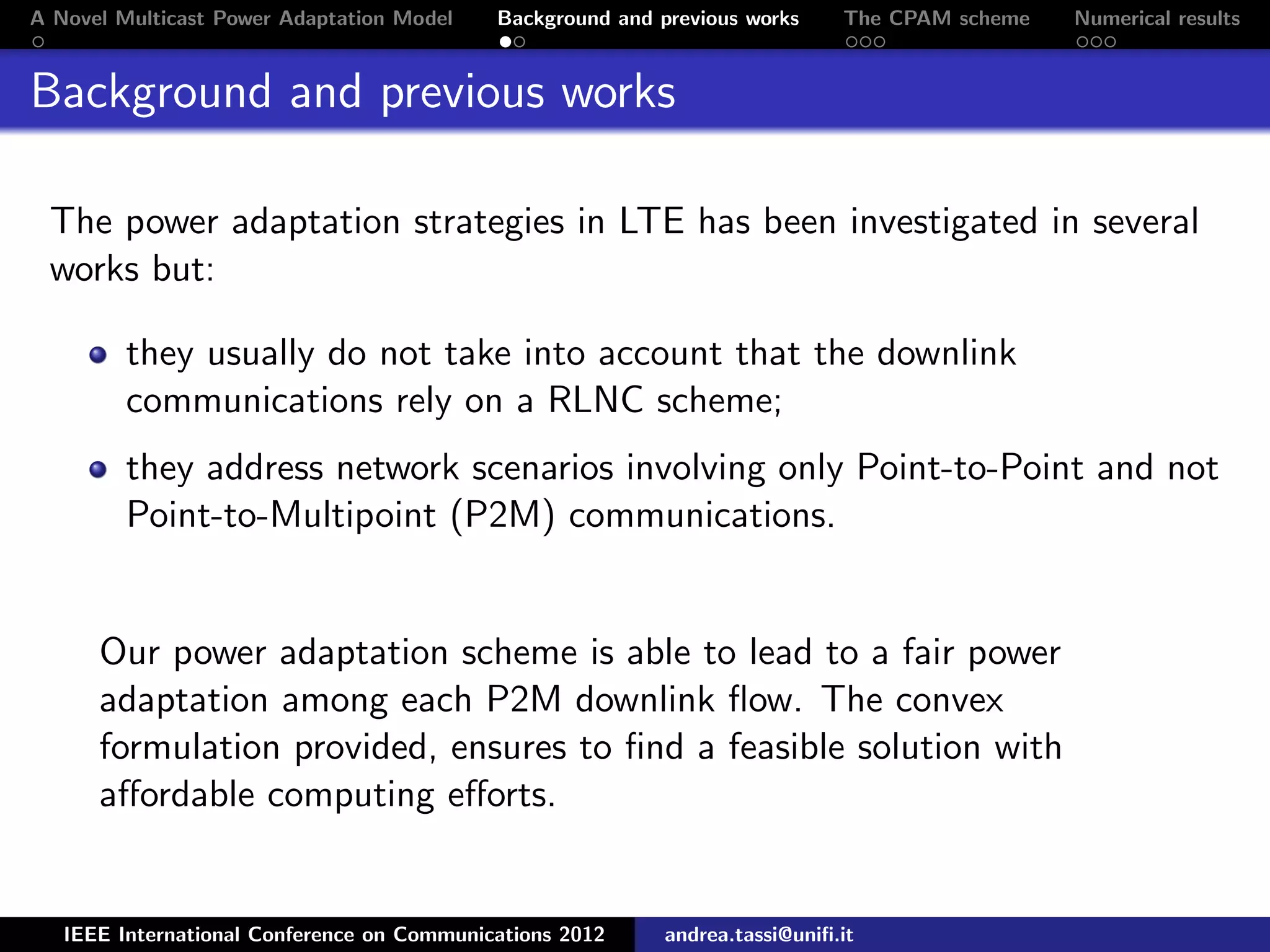
![A Novel Multicast Power Adaptation Model Background and previous works The CPAM scheme Numerical results Multicast Communication Model Linear NC coding The M = [s1; s2; . . . ; sl ] matrix is a message of l PDUs. A coded packet is obtained as: ri = M × ci , i = 1, . . . , l Linear NC decoding Whenever an UE collects l coded PDUs linearly independent it can recover the message as: M = [r1; r2; . . . ; rl ] R × [c1; c2; . . . ; cl ]−1 C−1 eNodeB MG2 MG1 MG3 MG4 Multicast network model: the eNodeB transmits to each MG a message until all members have successfully recovered it; UEs acknowledge messages with ACKs. IEEE International Conference on Communications 2012 andrea.tassi@unifi.it](https://image.slidesharecdn.com/icc12-slides-150125113942-conversion-gate01/75/Presentation-of-A-Novel-Convex-Power-Adaptation-Strategy-for-Multicast-Communications-using-Random-Linear-Network-Coding-Schemes-8-2048.jpg)
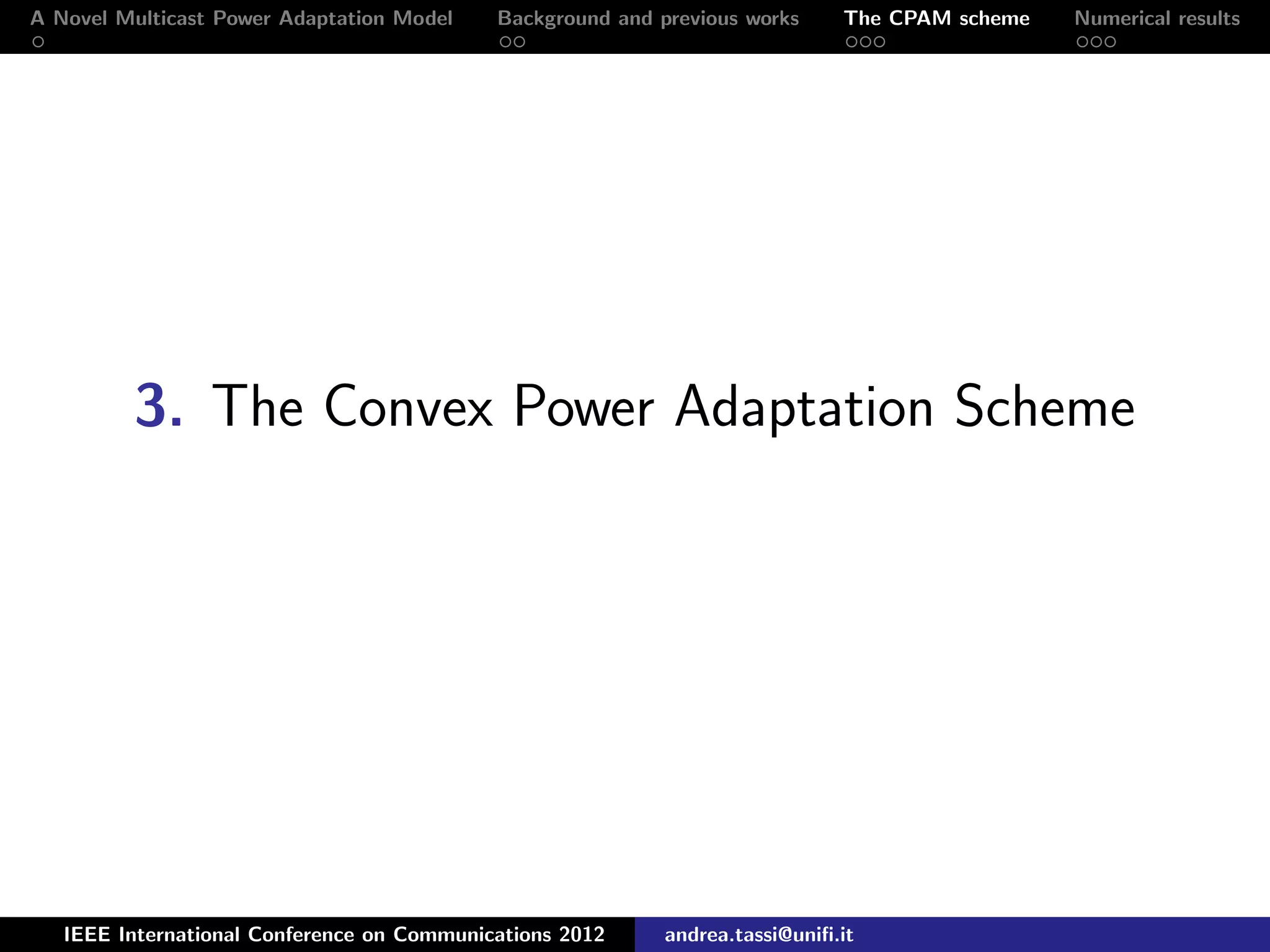
![A Novel Multicast Power Adaptation Model Background and previous works The CPAM scheme Numerical results Problem formulation (1/2) System model all resource allocation and power adaptation operations are performed on a frame-basis the downlink radio resources are modeled as a time/frequency matrix of O × S PRBs the system consists of K MGs where the b-th MG holds Wb UEs each downlink subframe holds Mb PDUs directed to the b-th MG Let ˆP be the maximum transmission power available for multicast transmissions. Transmission Power Constraint: O i=1 Pi,j ≤ ˆP ⇐⇒ O i=1 gi,j [b, t] xb,t ≤ O, (1) j = 1, . . . , S, b = 1, . . . , K, t = 1, . . . , Mk gi,j [b, t] tracks the disposition (within a frame) of each each P2M flow let xb,t be the Power Scaling Factor, the t-th PRB directed to the b-th MG is transmitted with a power Pi,j = ˆP O xb,t (2) IEEE International Conference on Communications 2012 andrea.tassi@unifi.it](https://image.slidesharecdn.com/icc12-slides-150125113942-conversion-gate01/75/Presentation-of-A-Novel-Convex-Power-Adaptation-Strategy-for-Multicast-Communications-using-Random-Linear-Network-Coding-Schemes-10-2048.jpg)
![A Novel Multicast Power Adaptation Model Background and previous works The CPAM scheme Numerical results Problem formulation (1/2) System model all resource allocation and power adaptation operations are performed on a frame-basis the downlink radio resources are modeled as a time/frequency matrix of O × S PRBs the system consists of K MGs where the b-th MG holds Wb UEs each downlink subframe holds Mb PDUs directed to the b-th MG Let ˆP be the maximum transmission power available for multicast transmissions. Transmission Power Constraint: O i=1 Pi,j ≤ ˆP ⇐⇒ O i=1 gi,j [b, t] xb,t ≤ O, (1) j = 1, . . . , S, b = 1, . . . , K, t = 1, . . . , Mk gi,j [b, t] tracks the disposition (within a frame) of each each P2M flow let xb,t be the Power Scaling Factor, the t-th PRB directed to the b-th MG is transmitted with a power Pi,j = ˆP O xb,t (2) IEEE International Conference on Communications 2012 andrea.tassi@unifi.it](https://image.slidesharecdn.com/icc12-slides-150125113942-conversion-gate01/75/Presentation-of-A-Novel-Convex-Power-Adaptation-Strategy-for-Multicast-Communications-using-Random-Linear-Network-Coding-Schemes-11-2048.jpg)
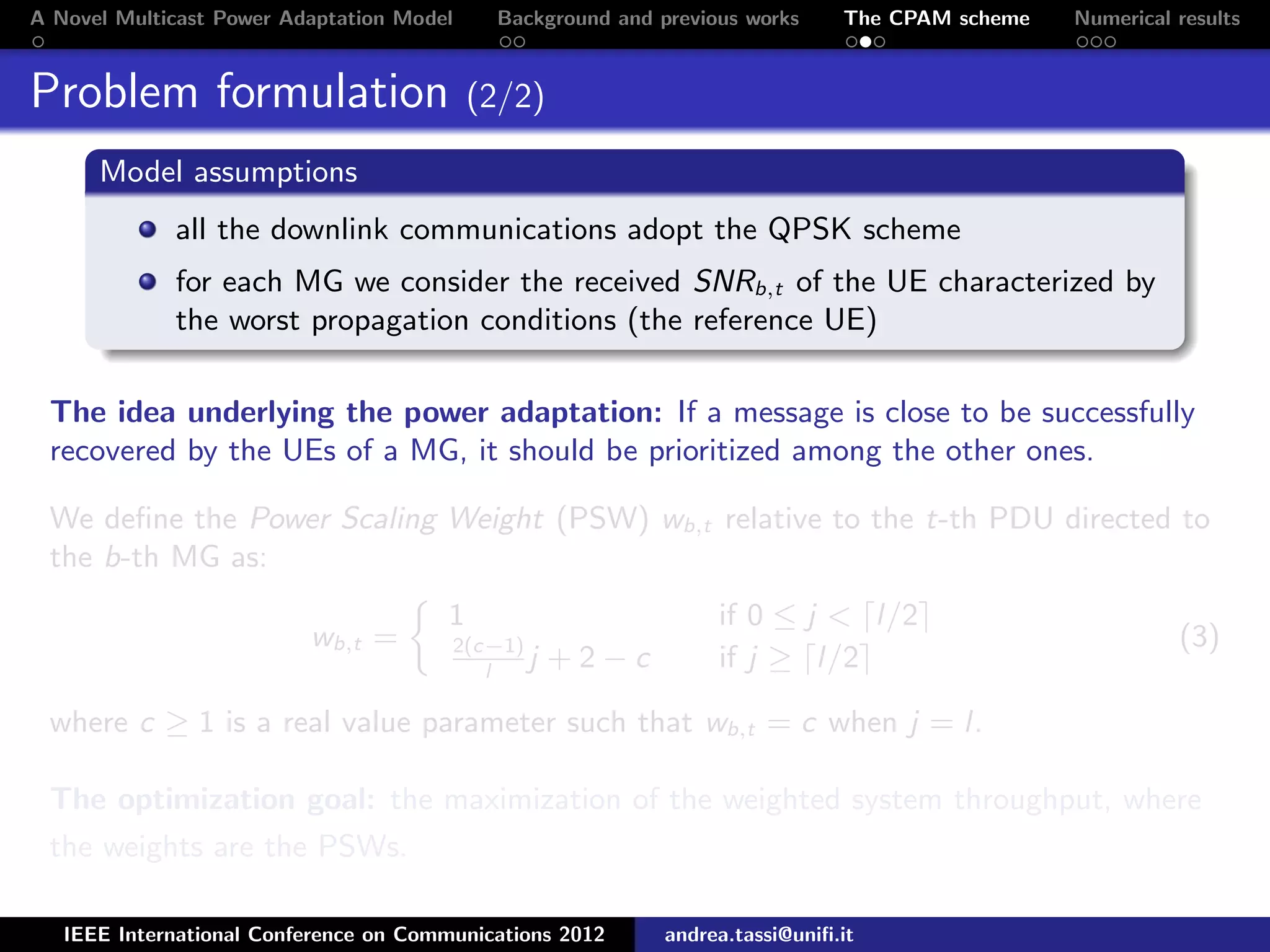
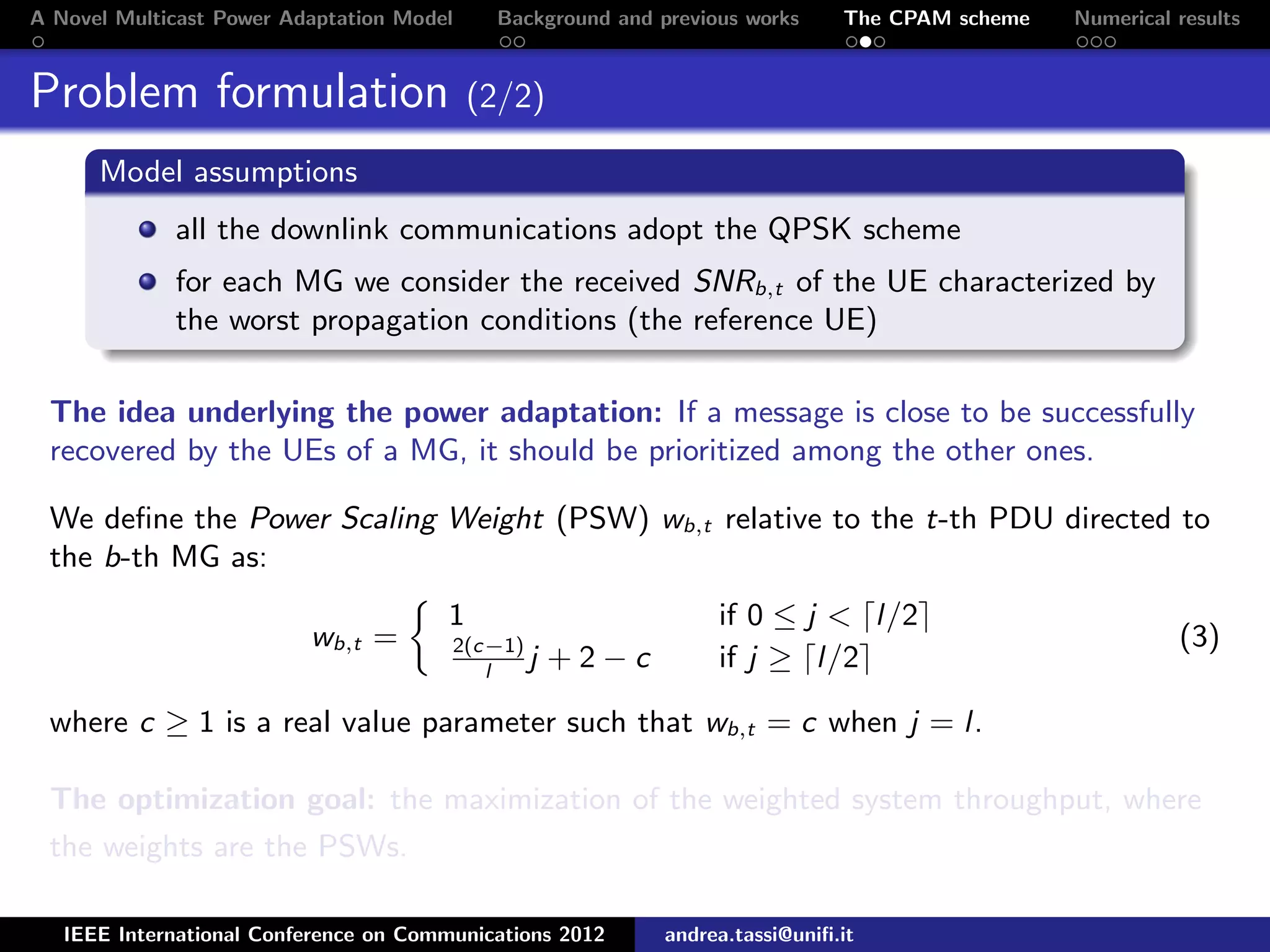
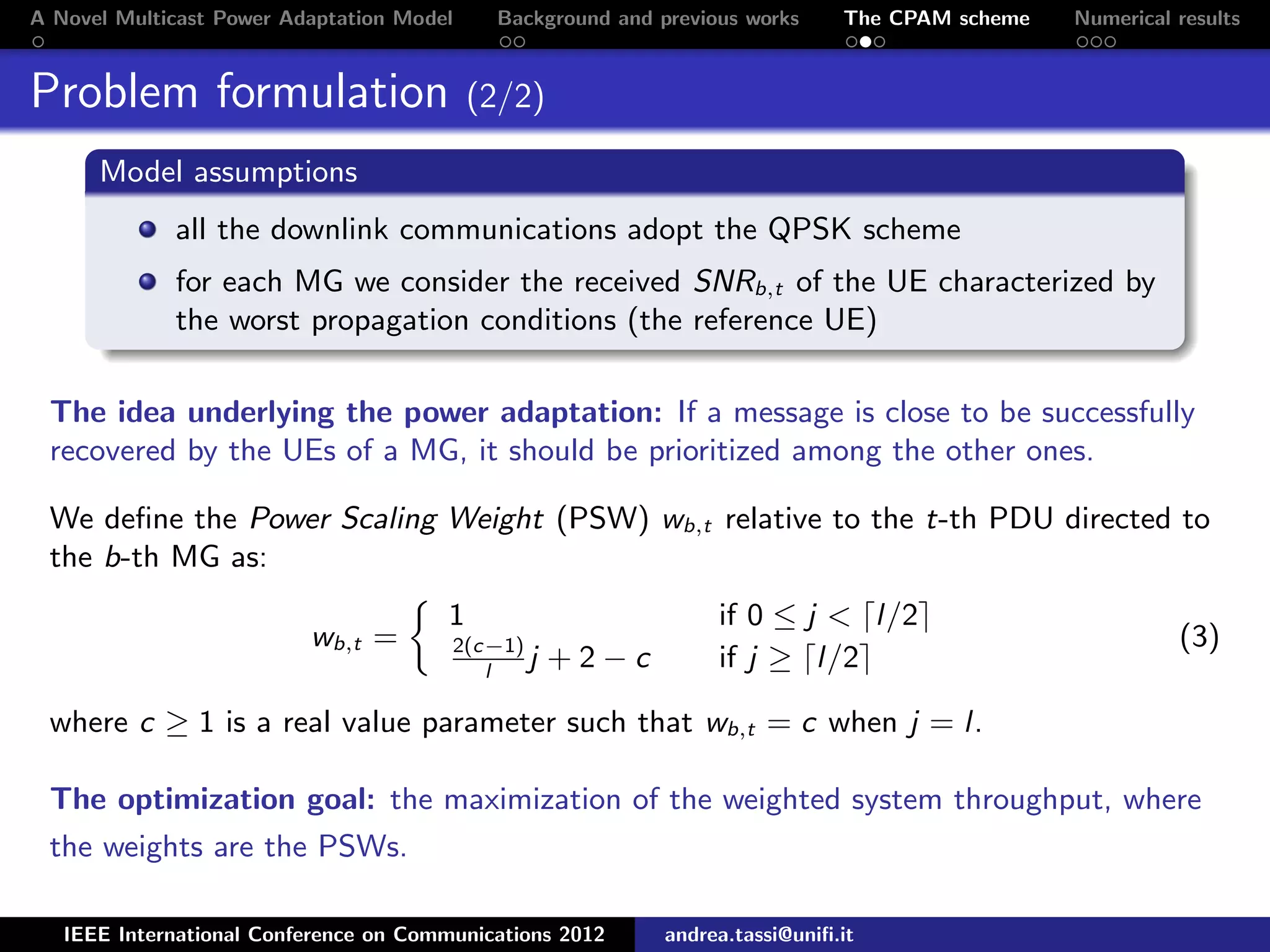
![A Novel Multicast Power Adaptation Model Background and previous works The CPAM scheme Numerical results The Convex Power Adaptation Model Concave envelope of the probability of correct reception of a PDU The function expressing the packet correct reception probability Pc(SNRb,t ) is non-concave, we define its concave envelope ˆPc(SNRb,t ) as: ˆPc(SNRb,t ) = Pc(Z) Z SNRb,t if 0 ≤ SNRb,t ≤ Z Pc(SNRb,t ) if SNRb,t > Z We can define the Convex Power Adaptation Model (CPAM) as: min xb,t − K b=1 Mb t=1 wb,t ˆPc SNRb,t (4) O i=1 gi,j [b, t] xb,t ≤ O j = 1, . . . , S, b = 1, . . . , K, (5) t = 1, . . . , Mk IEEE International Conference on Communications 2012 andrea.tassi@unifi.it](https://image.slidesharecdn.com/icc12-slides-150125113942-conversion-gate01/75/Presentation-of-A-Novel-Convex-Power-Adaptation-Strategy-for-Multicast-Communications-using-Random-Linear-Network-Coding-Schemes-15-2048.jpg)
![A Novel Multicast Power Adaptation Model Background and previous works The CPAM scheme Numerical results The Convex Power Adaptation Model Concave envelope of the probability of correct reception of a PDU The function expressing the packet correct reception probability Pc(SNRb,t ) is non-concave, we define its concave envelope ˆPc(SNRb,t ) as: ˆPc(SNRb,t ) = Pc(Z) Z SNRb,t if 0 ≤ SNRb,t ≤ Z Pc(SNRb,t ) if SNRb,t > Z We can define the Convex Power Adaptation Model (CPAM) as: min xb,t − K b=1 Mb t=1 wb,t ˆPc SNRb,t (4) O i=1 gi,j [b, t] xb,t ≤ O j = 1, . . . , S, b = 1, . . . , K, (5) t = 1, . . . , Mk IEEE International Conference on Communications 2012 andrea.tassi@unifi.it](https://image.slidesharecdn.com/icc12-slides-150125113942-conversion-gate01/75/Presentation-of-A-Novel-Convex-Power-Adaptation-Strategy-for-Multicast-Communications-using-Random-Linear-Network-Coding-Schemes-16-2048.jpg)
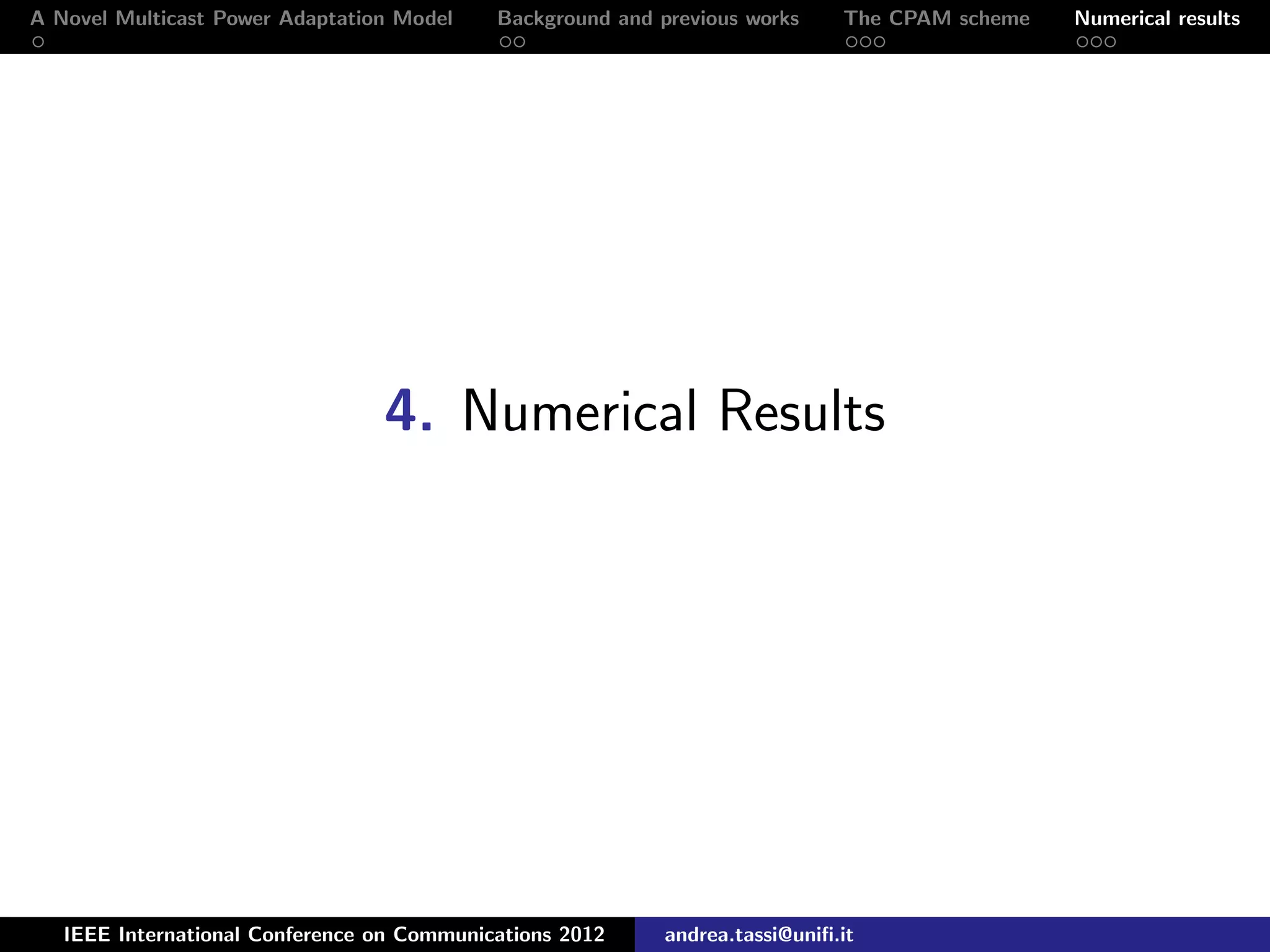
![A Novel Multicast Power Adaptation Model Background and previous works The CPAM scheme Numerical results The simulation parameters It has been simulated a system: 1. composed by an eNodeB and a variable number of MGs (5 ÷ 40) randomly placed within the cell; 2. where SNRb,t values are uniformly distributed between 4.5dB and 26dB; It has been compared the CPAM-S performance to the following strategies: the Fixed Allocation Strategy (FA-S) the Equalization Strategy (E-S) where each PSF (βb,t) is firstly calculated such as SNRb,t is equal to a target value1. Then the PSFs are normalized by a factor δ in order to respect the power constraint: xb,t = δ βb,t = O O i=1 gi,j [b, t] βb,t 1 To guarantee a PDU error probability less than 0.35. IEEE International Conference on Communications 2012 andrea.tassi@unifi.it](https://image.slidesharecdn.com/icc12-slides-150125113942-conversion-gate01/75/Presentation-of-A-Novel-Convex-Power-Adaptation-Strategy-for-Multicast-Communications-using-Random-Linear-Network-Coding-Schemes-18-2048.jpg)
![A Novel Multicast Power Adaptation Model Background and previous works The CPAM scheme Numerical results Average throughput of the worst and the best MG Receiving throughput of the worst MG 8 16 32 64 128 256 512 1024 30 40 50 60 70 80 90 100 110 Generation size [Number of PDUs] Averagethroughput[Kbit/s] CPAM−S f=21B FA−S f=21B E−S f=21B CPAM−S f=42B FA−S f=42B E−S f=42B 5 MGs, PDUs of 21 or 42 Bytes long IEEE International Conference on Communications 2012 andrea.tassi@unifi.it](https://image.slidesharecdn.com/icc12-slides-150125113942-conversion-gate01/75/Presentation-of-A-Novel-Convex-Power-Adaptation-Strategy-for-Multicast-Communications-using-Random-Linear-Network-Coding-Schemes-19-2048.jpg)
![A Novel Multicast Power Adaptation Model Background and previous works The CPAM scheme Numerical results Average throughput of the worst and the best MG Receiving throughput of the best MG 8 16 32 64 128 256 512 1024 50 60 70 80 90 100 110 120 130 140 150 160 170 Generation size [Number of PDUs] Averagethroughput[Kbit/s] CPAM−S f=21B FA−S f=21B E−S f=21B CPAM−S f=42B FA−S f=42B E−S f=42B 5 MGs, PDUs of 21 or 42 Bytes long IEEE International Conference on Communications 2012 andrea.tassi@unifi.it](https://image.slidesharecdn.com/icc12-slides-150125113942-conversion-gate01/75/Presentation-of-A-Novel-Convex-Power-Adaptation-Strategy-for-Multicast-Communications-using-Random-Linear-Network-Coding-Schemes-20-2048.jpg)
![A Novel Multicast Power Adaptation Model Background and previous works The CPAM scheme Numerical results Overall system throughput System throughput 8 16 32 64 128 256 512 1024 200 250 300 350 400 450 500 550 600 650 700 Generation size [Number of PDUs] Overallthroughput[Kbit/s] CPAM−S f=21B FA−S f=21B E−S f=21B CPAM−S f=42B FA−S f=42B E−S f=42B 5 MGs, PDUs of 21 or 42 Bytes long IEEE International Conference on Communications 2012 andrea.tassi@unifi.it](https://image.slidesharecdn.com/icc12-slides-150125113942-conversion-gate01/75/Presentation-of-A-Novel-Convex-Power-Adaptation-Strategy-for-Multicast-Communications-using-Random-Linear-Network-Coding-Schemes-21-2048.jpg)
